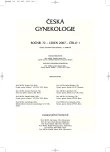Prospective Study the Prevalence of Different Candida Strains and their Sensitivity to Different Antimycotic Treatment in Women with Vulvovaginal Candidosis
Authors:
J. Vráblik 3; J. Mašata 1; A. Jedličková 2; M. Hajíčková 2
Authors‘ workplace:
Gynekologicko-porodnická klinika VFN a 1. LF UK Praha
přednosta prof. MUDr. A. Martan, DrSc.
1; ÚKLB, Klinická mikrobiologie a ATB centrum VFN a 1. LF UK Praha
přednosta prof. T. Zima, DrSc.
2; Gynekologicko-porodnické oddělení, Nemocnice Milosrdných bratří, Brno
prim. MUDr. I. Huvar, CSc.
3
Published in:
Ceska Gynekol 2007; 72(1): 27-32
Category:
Original Article
Overview
Objective:
Aim of this study was to ascertain the prevalence of differrent candida strains and their sensitivity to different antimycotic treatment in women with vulvovaginal candidosis.
Design:
Prospective study.
Setting:
Department of Obstetrics and Gynecology, 1st Faculty of Medicine and the General Faculty Hospital, Charles University, Prague. ÚKLB, Clinical microbiology and ATB center, 1st Faculty of Medicine and the General Faculty Hospital, Charles University, Prague.
Department of Obstetrics and Gynecology, Hospital Milosrdných bratří, Brno.
Patients:
124 women with symptomatic vulvovaginal candidosis were included in the study between January and October 2003. After complete clinical exam, vaginal pH, wet prep, the cultures were taken for special fungal examination.
Results:
In 92% of patient was confirmed infection with C. albicans, from topical antifugal agents were most sensitive to nystatin and pimaricin (100% cases), from oral antifugal agents to fluconasol, itraconasol and ketokonasol in 97-98% cases. C. nonalbicans strains were confirmed in 8% cases of vaginitis and there were similiar sensitivity to topical antifugal agents as in C. albicans strains. To oral antifugal agents there were in 10% resistance to fluconasol and in 20% to itraconasol.
Conclusion:
In this study we did not confirmed the higher prevalence of C. nonalbicans strains in vulvovaginal candidiasis, in literature the prevalence is 10-15%. We did not confirmed the increasing resistance to antifugal agents.
Key words:
Candida krusei, Candida glabrata, Candida lusitaniae, Candida parapsilosis, Candida tropicalis, Sacharomyces cerevisiae, fluconazol, clotrimazol, itraconazol, ketoconazol, econazol, pimaricin, nystatin
Labels
Paediatric gynaecology Gynaecology and obstetrics Reproduction medicineArticle was published in
Czech Gynaecology

2007 Issue 1
Most read in this issue
- Choroid Plexus Cysts and Risk of Trisomy 18. Modifications Regarding Maternal Age and Markers
- Efektivita měření nosní kosti jako UZ markeru pro Downův syndrom v 11.-13+6. týdnu gravidity
- Ovarian Hypertimulation Syndrome: a Review
- Laparoscopic Myomectomy: Indications and Limits
